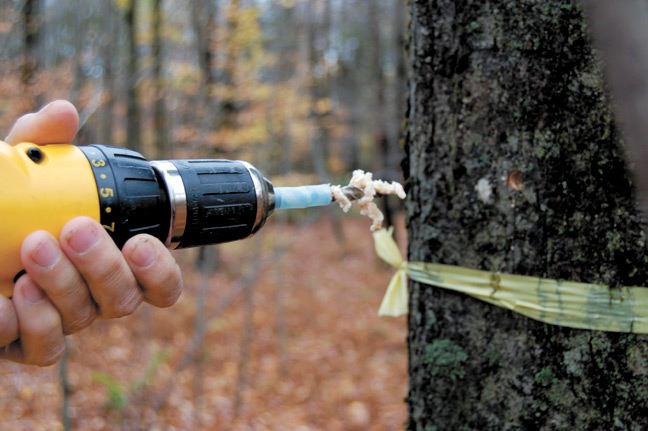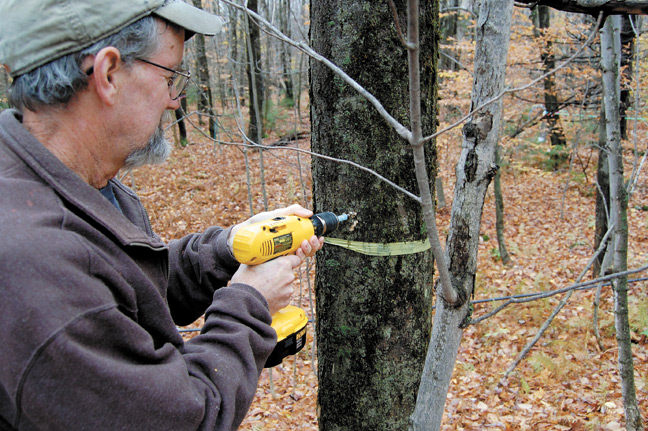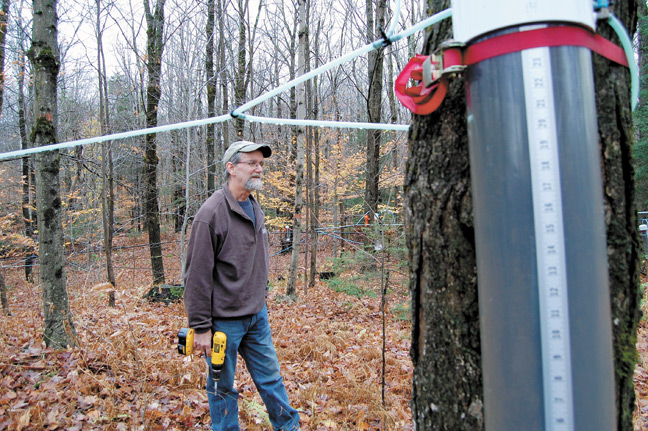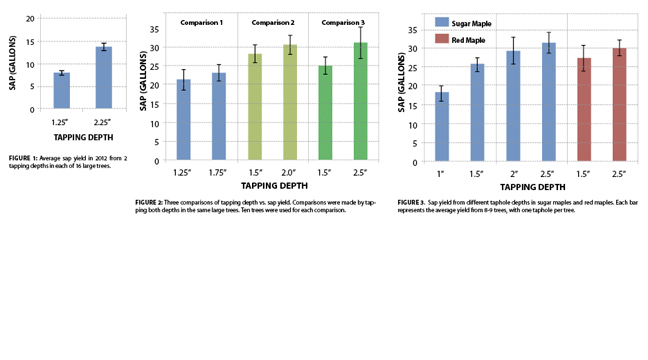UVM Proctor Page
Testing tapping depth vs. sap yield
Experiments under vacuum conditions demonstrated a trend toward greater sap yield with deeper holes
By TIM WILMOT |
Introduction: Although it is one of the more significant factors controlling the amount of sap we collect, there is little current published information that examines the relationship between taphole depth and sap yield under vacuum conditions.
For many years, sugarmakers were urged to drill deep holes (3” or more below the bark) in order to maximize sap flow (North American Maple Syrup Producers Manual, 1st Edition, 1996); however these recommendations were based upon relatively little research. The use of high vacuum and a general trend toward more conservative tapping practices has led to the adoption of shallower holes by many producers, as well as various recommendations to limit tapping depth. For example the 2nd Edition of the North American Maple Syrup Producers Manual (2006) suggests that tapping depth be no more than 2” below the bark. Additionally, many organizations that certify maple as organic restrict tapping depth. It is likely that many producers now tap even less than 2” below the bark, although differences of opinion exist.
In a 2011 survey of 122 sugarmakers (mostly from Vermont) using vacuum pumps, a little more than half of producers described their preferred depth as 1.5” from the outside of the bark. Another 16% reported tapping between 1” and 1.25”, 21% tapped between 1.75” and 2”, and 6% tapped deeper than 2”. While there are good reasons to limit taphole depth in order to maintain a healthy and sustainable tapping band, it is clear that there is no strong consensus on the optimum depth of the taphole based upon research or standard practice.
The goal of this project was therefore to examine the effects of tapping depth on sap yield under vacuum conditions.
Methods: The study took place during the sugaring seasons of 2012- 2014, and was performed at the University of Vermont Proctor Maple Research Center (PMRC) in Underhill Center, Vermont. All experimental trees were sugar maples, with the exception of 16 red maples tested in 2014. The sugarbush at the PMRC is complex in terms of the age, size, and tapping history of the trees, and two different areas of the site were used: an older section with trees mostly 17-30” in diameter, many of which have been tapped for at least 65 years, and a younger section with trees mostly less than 18” in diameter, which have been tapped for 5-15 years. In 2012 and 2013, the study was conducted in the older stand, and each large tree had two tapholes, one shallow, and one deeper, with holes drilled on opposite sides of the tree and offset vertically by 2-3 feet. In 2014, the study was conducted in the younger stand and a single taphole was drilled in each tree. In all cases, each taphole was fitted with a new 5/16” polycarbonate spout (CDL Smart Spout), attached to a new 36” dropline, which was connected to a 4 gallon vacuum chamber. The chambers allowed the sap from each hole to be collected continuously under vacuum and measured daily for volume. Sap sugar content from each chamber was measured on one or more occasions each season. Vacuum levels at the taphole were approximately 24” in 2012 and 2014, and 20” in 2013.
Taphole depths from 1” to 2.5” (measured from the outside of the bark) were tested, and the design of the study varied from year to year depending on the results from the previous year (Table 1). In all tests, sap was collected for the entire sugaring season. Differences between individual treatments for sap yield were tested statistically using paired Student’s T tests in 2012 and 2013, and differences between individual treatments were tested using Student’s T tests in 2014.
♥
Results and Discussion: The first two years of this study were performed by making comparisons within individual trees, i.e. each tree had one shallow and one deep taphole. This was done in an attempt to avoid unintentionally placing one of the test taphole depths in many trees that happened to be naturally superior in sap flow, and thus biasing the results.
2012 was a short sugaring season throughout much of the Northeast, with few sap runs and very warm temperatures in March. This may have influenced the results, but it unclear just how it did so. In this first year the difference in sap yields was rather dramatic (Figure 1). The average yield with the 2.25” deep hole was 70% greater than that from the 1.25” hole, and in every one of the 16 trees tested, the deeper hole produced more sap. Statistically, these results are highly significant.
♥
These two tapping depths were quite different and the very large increase in yield with the deeper hole suggested that more subtle differences in depth might also produce significant results. In 2013, large trees were also tapped with one deep and one shallow hole, this time using three comparisons (Figure 2). Spring 2013 was an ideal season for sap flow, and the long period of freeze/thaw weather resulted in yields that were more than double those of 2012 in both shallow and deep holes. Results, however, were much more ambiguous than in 2012.
♥
While each comparison showed that the deeper hole on average produced more sap, there was much variability; in several cases, the shallower hole produced more sap. None of these differences were statistically significant, i.e. all of these differences could be attributable to chance, as can be seen by the large and overlapping error bars. The largest difference observed was in the comparison of 1.5” tapping depth vs. 2.5.” In the case of these deeper holes, an additional and important phenomenon was observed—in drilling two of the 2.5” holes, the drill hit a compartment of brown wood from a previous taphole wound. Both of these holes yielded relatively small amounts of sap. Drilling deeper in trees with extensive tapping history imposes just this risk—that the hole will include non-functional (stained) wood from an old wound. The implications of this are discussed below.
In 2014, the experiments were moved to a younger stand with less tapping history. Because of the smaller size of these trees, only one hole per tree was drilled (Figure 3). In addition to sugar maples, two tapping depths were also tested in red maples.
♥
The results show a steady progression in sap yield from 1” to 2.5” depth, although statistically, only the 1” depth yielded significantly less sap than the other depths. Differences observed between 1.5”, 2” and 2.5” depth could be attributable to chance, as indicated by the large error bars, although the trend toward greater amounts of sap with deeper holes is apparent. Tapholes in red maples produced very similar results to sugar maple tapholes in 2014. None of the 2.5” deep tapholes, or any other tapholes in these trees intercepted stained wood, as occurred when tapping trees in 2013 that had been in production for many decades.
One of the only recent publications mentioning a test of sap yield vs. tapping depth is that of Stephen Guay (The Maple Grove: Ecology, Tapping, Landscaping) who reported that a tapping depth of 7 cm (2.75”) increased the sap yield by 45% compared to a tapping depth of 3 cm (1.2”), but did not report how variable or repeatable this increase was. The results for 2013 (above) show a very similar 46% average increase in sap yield with a tapping depth 2.5” compared to a depth of 1.25”. Results from 2014 showed an average increase of 74% with a tapping depth of 2.5” compared to 1”.
In addition to any effect that tapping depth may have on volume yield, any influence that depth had on sap sugar content would also affect syrup production. While sap sugar in this study was measured every year, the best data came from 2012, where there were two very different depths, and the comparisons were made within each tree, thus eliminating the bias of tree-to-tree differences in sap sugar. In the three 2012 dates where sap sugar content was measured, the deeper holes were slightly less sweet (average about 0.1% brix) but this was not consistent among all trees, and was not statistically significant and would thus have little or no effect on total syrup production based upon taphole depth.
The long-term sustainability of sap production from maple trees depends on maintaining healthy, functional sapwood. Every wound, including those made by tapping bits, creates an area of non-functional wood in the trunk, roughly corresponding to the area of dark stain that appears in the wood above and below an old taphole. Drilling into this stained wood leads to a less productive, or non-productive hole. A deeper hole is more likely to strike a buried column of non-functional wood from an old wound (as happened in this study in 2013 with some of the 2.5” deep tapholes), and the chance of this happening increases with the number of years the tree has been tapped, as well as with other factors, such as the diameter growth rate, the annual number of tapholes per tree, and whether or not the producer has spread out the tapholes over a large area of the trunk. Additionally, in some trees, particularly red maples, a large core of heartwood exists inside the trunk, and a deep taphole in a relatively small diameter tree may strike this heartwood and cause a large non-functional compartment to be created around the wound. The chances of tapping into non-functional wood for trees of different sizes and using different tapping guidelines can be explored using an interactive Excel spreadsheet created by PMRC researcher Abby van den Berg, found at this address: http://www.uvm.edu/~pmrc/?Page=tappingguidelines.htm
♥
Summary: This study was conducted as part of a larger effort at the University of Vermont Proctor Maple Research Center to develop research-based tapping guidelines that optimize both sap yield and tree health. Results from three years of experiments comparing taphole depth and sap yield under vacuum conditions repeatedly demonstrated a trend toward greater sap yield with deeper holes, up to a depth of 2.5” from the outside of the bark. While this trend was apparent every year, variability among trees was often large and unpredictable—deeper holes did not always yield more sap than shallower holes. In two years, 2012 and 2014, the difference in sap yield between the shallowest holes tested—1” or 1.25” depth, measured from the outside of the bark, and a taphole that was at least 0.5” deeper, was statistically significant.
Thus it is concluded that tapholes as shallow as 1”to 1.25” are not optimum for sap collection, but may be considered if reducing stem wounding and accompanying compartmentalization is necessary. Holes deeper than 2.5” from the outside of the bark were not tested, and producers are cautioned that drilling holes even this deep increases the chance that the drill bit will strike a compartment of stained, non-functional wood that will yield little or no sap. The choice of tapping depth should always be considered with the goal not only of maximizing sap yield, but also protecting the resource in light of each tree’s health, growth rate, canopy position and tapping history.
This study was partially funded by a grant from the Chittenden County (Vermont) Maple Sugar Makers Association.
November 2014



































